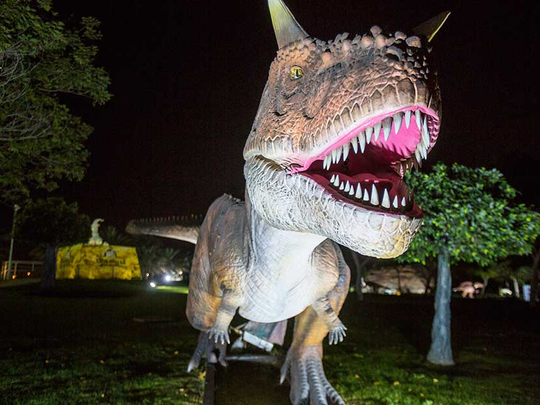
Humans didn’t always rule this planet.
Long before we populated caves, foraged for food across plains and crossed the Bering land bridge between Asia and North America in the last ice age, fascinating creatures roamed the Earth.
Some were tall enough to tower above a giraffe; others could see further than a hawk; and some subsisted on 400kg of vegetation a day.
From novels by the likes of Michael Crichton to video games such as Horizon Zero Dawn, the place of these great, prehistoric beasts in pop culture is unquestionable.
As palaeontologists unearth new finds and Hollywood delivers increasingly terrifying CGI-built creations, our curiosity about dinosaurs shows no sign of abating.
We look at some weird, wonderful facts around three of the most interesting creatures you can visit at Dubai Garden Glow’s live-action Dinosaur Park. The outdoor theme park in the UAE is open to visitors right now.
ANCIENT EMPEROR: TYRANNOSAURUS REX
• Its 60,000-newton pressure bite can chew on 230kg of meat at once
• T-rex can see 13 times further than you can
• It ate armoured triceratops, smaller dinosaurs and even its own kind
What has a mean bite, eyes sharp enough to spot prey 6 kilometres away and a 23kph running speed? Say hello to the sizeable jaws of the infamous Tyrannosaurus Rex (T-rex). The King of the Tyrant lizards had the meanest bite of any creature to have ever walked the Earth – about 60,000 newtons or 12,800 pounds of pressure – and could chomp down on 230kg of flesh in one mouthful. That’s a little over 5,000 Big Macs.
There was a brain behind that bite, too. Besides its long-distance vision T-rex had a keen sense of both sight and smell, with visual acuity 13 times that of a human with 20:20 vision, 55-degree binocular vision, which surpasses a modern hawk, and olfactory bulbs and nerves that led scientists to suggest this carnivore had a vulture-like sense of smell.
This king of the dinosaurs, ensconced in his own enclosure at Dubai Garden Glow, sat comfortably atop the prehistoric food chain. Teeth marks found on skeletal remains indicate this apex predator gorged on everything from the harmless duck-billed hadrosaur to the armoured, three-horned triceratops – no mean feat, given the latter’s formidable natural defences.
T-rex became the stuff of many children’s nightmares after its iconic entry in Steven Spielberg’s Jurassic Park.
TALL TITAN: BRACHIOSAURUS
• Weighing 45 tons and standing 26 metres tall, this may be the largest creature to have ever walked the earth
• In weight terms, it ate 73 times as much as a human on a daily basis
• Remains of its relative, the titanosaurian, have been found in the Gulf
Unlike North America, East Africa and the Far East, palaeontologists have traditionally had a tough time finding fossils in the Arabian Peninsula, owing to the fact that much of this area was covered by sea throughout the era of the dinosaurs. However, a 2013 paper by Sweden’s Uppsala University noted the recent discovery in Saudi Arabia of fossilised remains of a titanosaurian – a group comprising some of the largest creatures to have ever walked the earth.
Its cousin, brachiosaurus, is a fellow sauropod (a family of long-necked herbivorous dinosaurs). Weighing an estimated 45 tons – the equivalent of 16 Nissan Patrols – brachiosaurus towered over the land, munching as much as 400kg of tree-top foliage on a daily basis. According to the Abu Dhabi Food Control Authority, the average UAE resident consumed 1,486kg of food in 2013 – less than five days of sustenance for a brachiosaurus.
The 26-metre-tall dinosaur, one of the largest at Dubai Garden Glow, takes its name from the Greek words brátso, which means arm, and sauros, or lizard, a reference to the dinosaur’s front legs being longer than those at the back. With its first fossils discovered in Colorado in 1900, brachiosaurus is perhaps best known for having appeared in Jurassic Park – fitting, given that the creature lived in the late Jurassic period about 151 million years ago. Less accurate is the Steven Spielberg film’s portrayal of brachiosaurus rearing up on its hind legs – in 2011's Biology of the Sauropod Dinosaurs, palaeontologist Heinrich Mallison wrote that the dinosaur’s body and limb shape would have made such movement fairly taxing.
WINGED WONDER: PTEROSAUR
• Some of these weighed less than 6kg but had a 22-foot wingspan
• Would scoop up fish with a pelican-like throat pouch
• Had wings made of a stretchy, skin and muscle membrane, similar to a bat’s
These winged reptiles soared through the skies of the Cretaceous period 228 to 66 million years ago. Best known for the pterodactyl, the Pterosaur actually encompassed at least 130 generations that ranged in size from that of a hummingbird (anurognathus) to the giraffe-sized quetzalcoatlus. While pterosaur flew above them, it wasn’t technically a dinosaur or even an ancestor of modern birds. Rather, it is widely considered to have evolved convergent to bats and birds. The creature’s name means winged finger in Greek. This is due to the pterosaur’s wings, which comprised a unique membrane of skin and muscle stretching between a protracted fourth finger on its hand to the hind limbs – an anatomy similar to that of a bat.
Pterosaur flew across the prehistoric globe, with the closest discovery to the UAE being a find in Kenya, which was then part of the vast Gondwanan supercontinent that encompassed Africa, Arabia, Antarctica, the Indian subcontinent and South America throughout the Cretaceous period.
To feed, pterosaurs relied on their speed, which may have reached 108kph, and a pelican-like throat pouch that would scoop unsuspecting fish from the shallow inland seas common in the Cretaceous era. The unfortunate prey would then feel the bite of razor-sharp teeth.
Thanks to its hollow bones, the animal could have weighed as little as 5.5kg, even with a wingspan crossing 22 feet (in the pterodactyl).












